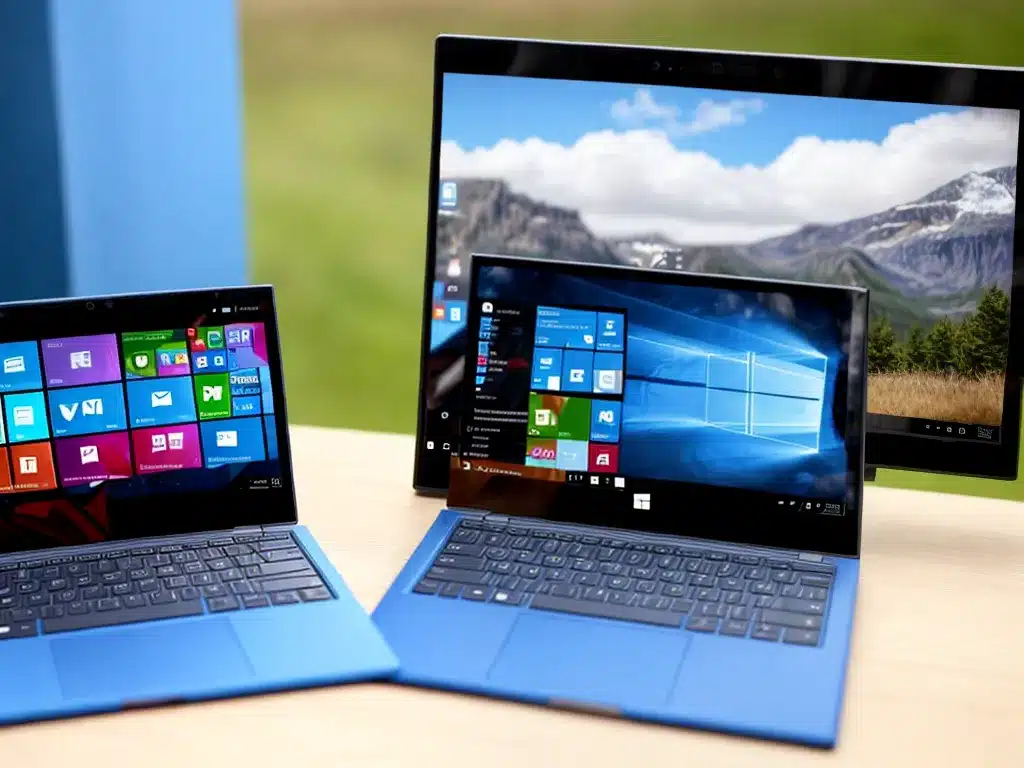
I’ve been using Windows for over 20 years now, so I’m very familiar with the evolution of Microsoft’s operating system over time. Windows 11 is the latest iteration, officially released in October 2021. But Windows 10 is still widely used today. So which one is better for you? Here’s an in-depth comparison of Windows 11 and Windows 10 to help you decide.
Interface and Design
Windows 11 features a refreshed visual design with rounded corners, pastel colors, and a centered Start menu and taskbar. This gives it a more modern and minimalist look compared to Windows 10.
I really like the centered alignment, muted colors, and refined aesthetics of Windows 11. It looks cleaner and feels more visually soothing to me. The centered taskbar also makes better use of widescreen displays.
However, the change is quite drastic if you’re used to the left-aligned taskbar in Windows 10. It will take some adjustment to get used to. Some users may prefer the familiarity of Windows 10’s interface.
Overall, Windows 11 has a more contemporary and streamlined interface design than Windows 10. But the drastic changes could be off-putting to some longtime Windows users.
Performance
In my experience so far, Windows 11 feels slightly smoother and more responsive than Windows 10 when performing common tasks like opening apps and multitasking.
Microsoft has made under-the-hood improvements to the OS architecture and memory management in Windows 11. This seems to translate to a modest performance boost over Windows 10 in daily use.
However, when it comes to gaming or intensive workloads like video editing, any performance differences are marginal at best. Synthetic benchmarks show that Windows 11 has a slight edge in overall system performance compared to Windows 10. But it’s not a drastic change.
If you have a modern system with at least an Intel 8th gen or AMD Ryzen 2000 series processor, you’ll enjoy responsive performance in both operating systems. The difference is not big enough to be a deciding factor.
Features
Windows 11 comes with a few handy new features, like:
- Snap layouts – Organize apps in preset window arrangements for multitasking.
- Widgets – See information like weather, news, and calendar events in a glanceable feed.
- Android apps support – Run Android apps on Windows for the first time.
- Teams integration – Deeply integrated Microsoft Teams chat and meetings.
- Enhanced touchscreen support – Better gestures and haptics for 2-in-1 devices.
However, Windows 10 already has many robust features like Timeline, virtual desktops, and a polished Settings app. Key advantages like the Start menu, Task Manager, and File Explorer work similarly in both operating systems.
So in terms of functionality, Windows 11 doesn’t provide a dramatic upgrade over Windows 10. But the new features are nice additions if you want a more modern and touch-friendly experience.
Security
Microsoft positions Windows 11 as their most secure Windows version yet. It ships with new security technologies like hardware-enforced stack protection, hypervisor-protected code integrity, and secured-core PCs.
These improvements harden the operating system against advanced cybersecurity threats. Windows 11 also exclusively supports the TPM 2.0 security standard for enhanced encryption and attestation.
Windows 10 is still serviceable in terms of security. But Windows 11 goes a step further to lock down the OS and thwart sophisticated malware attacks. This makes it ideal for security-conscious individuals and organizations.
System Requirements
Here’s a quick rundown of the minimum system requirements for both operating systems:
Windows 10
– 1 GHz processor (2 GHz for 64-bit)
– 1 GB RAM (2 GB for 64-bit)
– 16 GB storage
– DirectX 9 graphics
– 800×600 display
Windows 11
– 1 GHz dual-core 64-bit processor
– 4 GB RAM
– 64 GB storage
– DirectX 12 compatible graphics
– 720p display
– TPM 2.0 module
– Secure boot capable
The requirements for Windows 11 are considerably higher, especially the TPM and processor specifications. Most PCs from the last 5-6 years meet the requirements. But Windows 11 definitively ends support for older systems in exchange for enhanced security.
Verdict
Ultimately, Windows 11 offers visual refinements, new features, and security upgrades that make it an appealing option for modern PCs. But Windows 10 remains a robust, familiar, and highly capable operating system.
If you own relatively new hardware and want the latest user interface and security features, Windows 11 is the better choice. But sticking with Windows 10 is just fine for general productivity and entertainment needs, especially on aging computers.
Evaluate your priorities and hardware capabilities. For most mainstream users on modern systems, Windows 11 is a worthwhile upgrade. But it’s not universally better than the reliable Windows 10 yet. I suggest clean installing Windows 11 while keeping a backup image of Windows 10 for flexibility.












